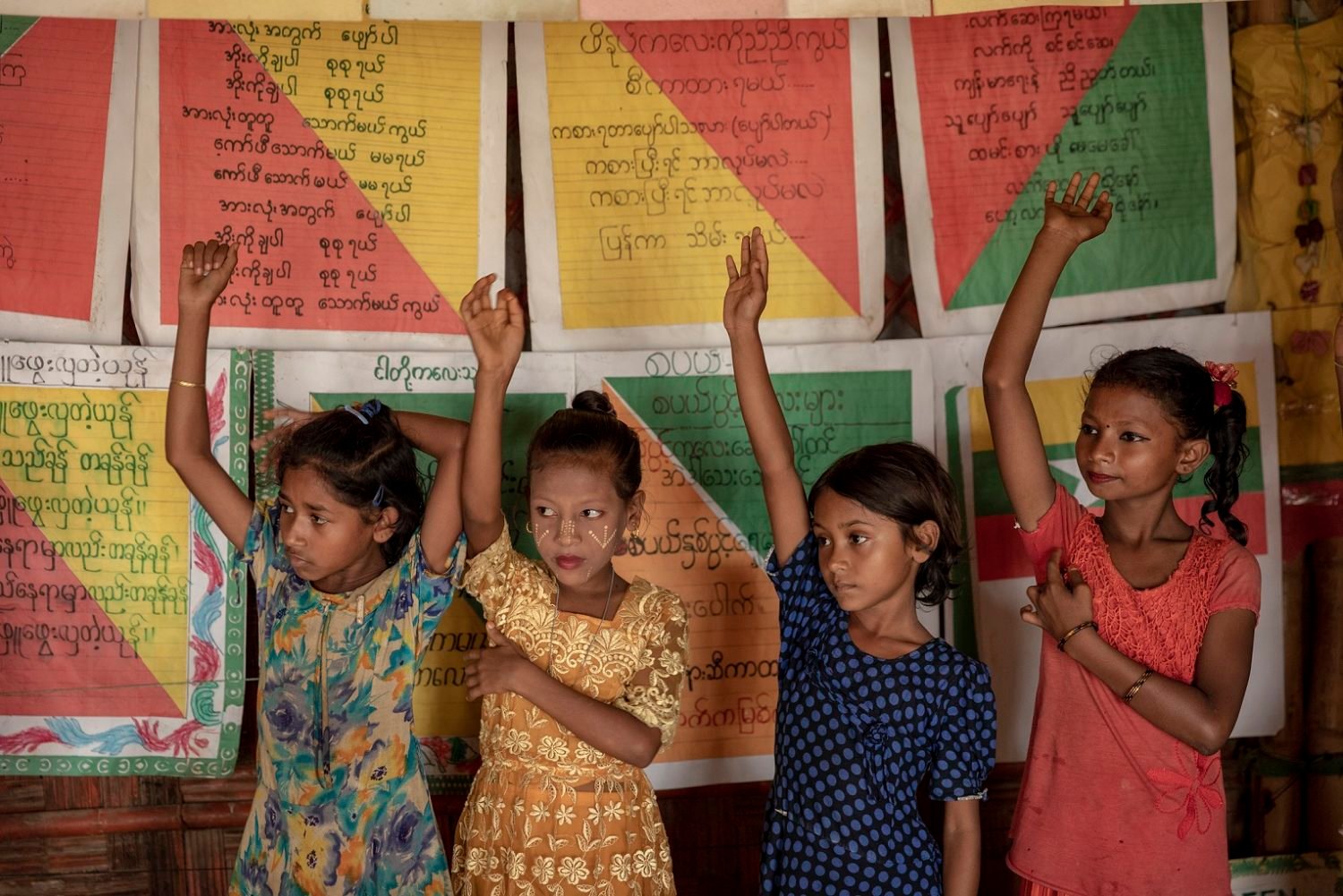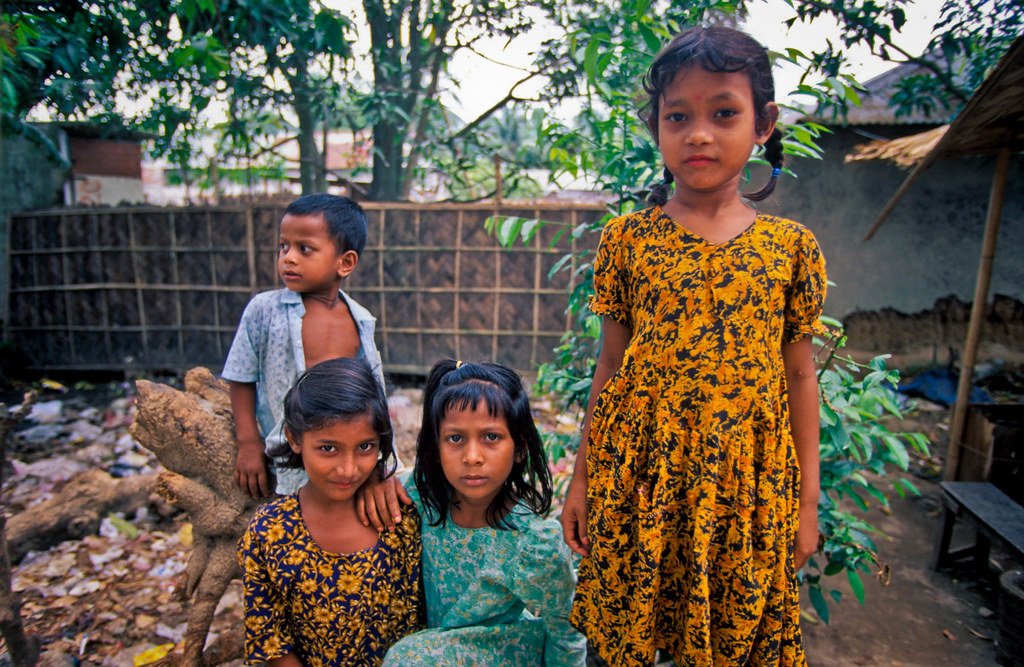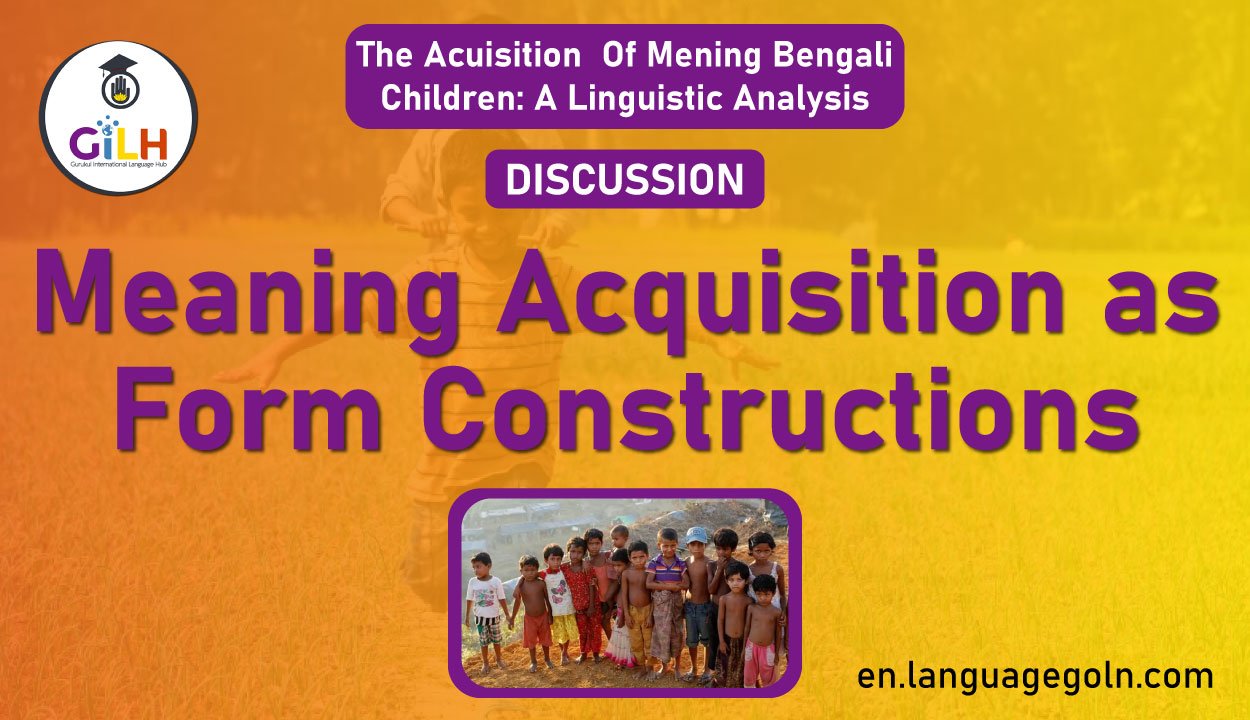Today our topic of discussion is – Meaning acquisition as form constructions
Meaning acquisition as form constructions
When I was analyzing the data, I have seen that children’s earliest multi word utterances or word combinations consisted of the same things (almost) that they have corresponded to in the ‘holophrase’ or ‘pre-linguistic’ stage; later around (after 2 years) they become capable of linking up other’s actions, object properties and reappearance, locations of people and similar features like these.
For example, identifying something or signifying anything they know already.
Like-/miaw/(“cat”) → /ækta miaw/= (‘one cat’) /oi je ækta meaw/ or
/ækta Jada meaw/= (‘There is a cat’ or ‘a white cat’)→→
/oi je ækta jada meaw wale boje ase. /= (“look a white cat is sitting on the wall”) etc.
Matthews et al. (2005) also gave evidence of such data in his research also. According to them such utterances take some common forms and these forms could be
classified systematically.

A brief presentation of the classification of abstract constructions of children’s utterances by the researchers is presented below with necessary examples taken from the data
collected in this research:
-statements (declaratives) =/oi je aekta gari!/= (There is a car!)
-requests (imperatives) =/oita amake dao/=(Give it to me.)
-questions=/muggi ta kotay galo?/= (Where did the chicken go?)
-performatives=/bai or hælo/= (Bye/ Hello.)
-negation constructions=/ami dibo na/= (I will not give.)
-complex constructions=/amio jete cai!/= (I also want to go.) or
/oitai to amar kukur ta./= (That is my dog).
Children construct these by observing the adults’ language use and related actions mainly. They take input on a continuous basis to cope with their current situations (which might be expected or suddenly created). Data of earliest multi-unit utterances can be
classified and analyzed in the following four types trailing Tomasello’s work (Matthews et
al., 2005).
(a) Word-combination
(b) Pivot schemas
(c) Item based constructions
(d) Abstract Constructions
Research findings relevant to these four classes will be discussed in the following
segments:
(a) Word combinations: Around at the beginning of 18 months, many children start combining two words or holophrases in situations where both are relevant (Tomasello, 2003). Almost all of the children of this research started using word combinations when they turned one and a half years (or a few months later); like-/gari bum bum/=(to describe the noise of the car), /dagi nai/=(to express the absence of the dog) etc.
I also observed that, the children’s first word combinations are like combining two ideas and children have to know words with equivalent status for the combination. For example-/baba juta/= (father’s shoes) or /mamma kol/= (take me to lap) etc. Gradually verbs start to include in their language, like-/dudu dao/= (give milk), /bebi jampa/ = (the baby is jumping).
The inclusion of verbs is important in the sense that children begin to know the function of word classes and start comprehending language systematically. One interesting fact about this level is that children seem to set rules of joining words on their own, like-/dim na/=(I don’t want egg), /baba tata/=(father went out), /aro mam/=([
want more milk) etc.
Sometimes children use ‘thank you’, ‘good night’ and ‘bye bye’ in their everyday speech. According to Lowry, parents may think of these as evidences of word combination, but these expressions are actually memorized as word ‘chunk’ of language.
Children do not become capable of combining either of these words with other words to form new combinations like, “Thank you mother’ or ‘starry night’ (Earl & Lowry, 2015). For the participant Bengali children of this research- these word combinations are memorized ‘chunk of the words of the English language.
Generally, children are not taught the Bengali forms of these words (with quite a few exceptions) from their early childhood, they learn the Bengali version of these expressions ‘chunks’ later from school or from contextual conversations at home (mostly).

One of the major characters of the usage based approach is that word combinations divide the experiential scene into several symbolizable units (Tomasello, 2003). Holophrases do not create meaning in this way as they are completely concrete in the sense that they consist only of concrete parts of the language, not of abstract categories (noun, verb).
(b) Pivot schemas: Within a few months of producing the first multi unit utterances, children begin to show visible progress in producing more complex utterances with systematic patterns. They are often organized as specific words and show functional asymmetry between the involved components.
One word seems like structuring the utterance by determining the speech act function as a whole, and the other one occupies a variable slot. Such schemas are described as pivot schemas. These structures take place independently of each other and are attached to lexical items (Tomasello, 2003).
Pivot words actually work as links between ‘holophrastic’ and ‘multi-unit utterance”
common structure while using the pivot words. Children use such schema to mean something specific before they actually master rules for them. Thus, using pivot words is like applying child’s own rules to express something specifically. For instance-
-The child Ikra used the number ‘two’ to refer to any quantity-/duita kap/= (two cups), /duita dudu/= (two milks etc.) or
-Anna used to say-/dim na/= (not egg), /thal na/= (not spicy) etc.
They want the audience to focus only on the words that express their expected meaning. In the above cases, ‘milk’, ‘cup’, ‘egg’ or ‘spicy’ are not the words that express the main meaning, these are the ‘open’ words.
The number ‘two’ or ‘no’ are the pivotal words here expressing intended meaning to the listener. Pivotal words can take the form of a complete sentence individually (mostly in the form of an answer to any question) or these words can be used in a sentence too. Like-
C:/jobgula nak bæta/ (pain in ‘all’ the nose) or /fobgula amar/ (all are mine) etc.
In 1971, Slobin found through his research that children approximately of the same age (18-30 months in general) in different languages expressed similar kinds of meanings with the use of the so called ‘pivot schemas”.

I think the use of such schemas can be seen as earliest effort to code the functional categories of the language when the children’s utterances express only one function, one meaning at a time. Through the development of structural use of language (grammar), they manage to express several functions and meanings simultaneously.
(c) Item based constructions: Structuring constructions are another vital way in language development, in which children map forms with particular meanings (Goldberg,
1998). Like words, constructions are symbolic entities used to map particular meaning or function to particular forms. For example, any imperative sentence can be seen as a complex linguistic sign, in which particular patterns are constructed to perform an illocutionary force. Like-
/cup koro!/=(keep quiet)
/dorja kolo!/=(open the door) etc.
On the basis of my data I can say, item based constructions as a medium of semantic mapping start at a very early stage as the form of isolated word production. It is followed by a multi-word expression chunks. Theoretically, these early utterances or ‘holophrases’ are related to particular communicative situations accomplishing specific communicative goals (Tomasello, 2003).
Children produce these item based constructions as a compilation of smaller unit or they can produce content questions too. These questions can be featured with intonation contour also. In the data analysis chapter I have coded few data under the titles- ‘form- meaning mapping”, “form- meaning mapping error’ and ‘asking questions’.
Children’s semantic mapping is actually the result of structuring item- based constructions. A successful accomplishment of this process leads to acquiring the use of ‘pivot schemas’ and making early attempts of asking questions.
(d) Abstract constructions: Abstract constructions in language development play the vital role in pairing complex forms with complex semantic or pragmatic functions. But children do not experience constructions; initially they create utterances as concrete pieces of language, in several different shapes and sizes, and then generalize them to develop more
abstract linguistic constructions (Tomasello, 2003). Such constructions are central to theoretical buildup and it enables children to generate new utterances too.
These abstract or linguistic constructions are prototypically language units consisting of several linguistic elements used in a relatively cohesive communicative process together.
These linguistic elements perform sub-functions as well. Children start with learning words followed by combinatory rules. But the question is how do the children do that? I have observed that this process of language construction aiming to make meaning for successful communication comes as a gradual process but without showing any visible segmentation.
They hear and then try to understand entire adult utterances, instantiating different kinds of constructions used for different communicative purposes. Although children begin by learning individual words, they are often featured with traditional international patterns that signify requests, comments, questions etc.
Later, they match up to adults’ use of more complex constructions as a form of effective speech act corresponding to whole language constructions. Moreover, if we explain language constructions from a structural perspective, we can refer to Ferdinand de Saussure, the pioneer of structuralism.
According to him, language is an abstract system of signs (grammatical, syntactic, semantic, phonetic or lexical) and they make the basis of all speaking, or simply ‘language in use’. They are interrelated and interconnected expressing the same idea through different means of language.
For example- C:/pin kalar dao./=(Give me ‘pink’, means I do not want any other colour)
C:/amar pochondo na./=(I do not like, means ‘I dislike’)
If grammar is the main abstract construction of a language, it is worth to mention that- grammatical elements are unities of meaning and form, content and expression (Sag et
2012). A grammar reflects the paradigmatic (meaning of words) and syntagmatic (syntactic meaning) of a language. Categories analyzed in this research such as ‘using linguistic features’ (intonations, use of verb-forms etc.) are all part of abstract constructions of a language.
Usually children are seen to be over generalizing the language at the beginning of meaning mapping, this is also a part of linguistic construction aiming to acquire the actual content-expression relationship of a language.
These points are discussed here with relevant examples that are collected as data during the research to present the systematic process of child language acquisition; these processes resulted out in meaning acquisition or semantic mapping of the target language.
The theoretical basis of my research which is the ‘usage based approach’ also supports the above steps as the foundation for child language acquisition. Thus we can conclude that early ontogeny of child language focuses on-
(a) the language children hear,
(b) their early holophrases,
(c) early word combinations,
(d) using pivot schemas, (e) item based constructions and finally
(e) focusing on linguistic or abstract constructions used to mark basic syntactic rules to ensure
proper semantic representations (Tomasello, 2007).
The above sections cover the whole idea and levels of child semantic mapping or meaning acquisition in general. But on the basis of my collected data and coded categories I want to present the following segments which I think are worth mentioning to know the underlying factors of child meaning acquisition process more clearly and at the same time it will be helpful to answer to the research questions also.
See more
